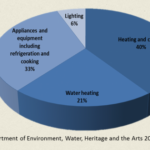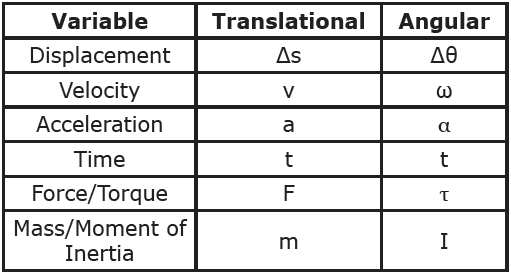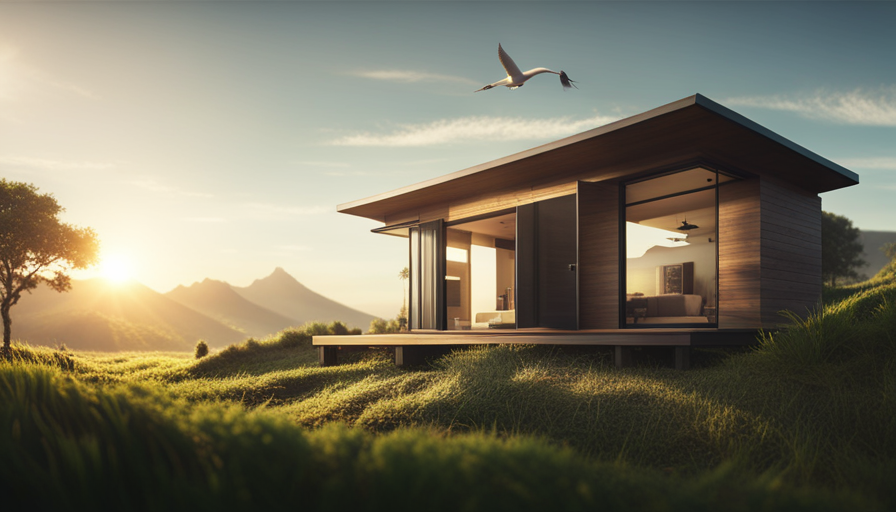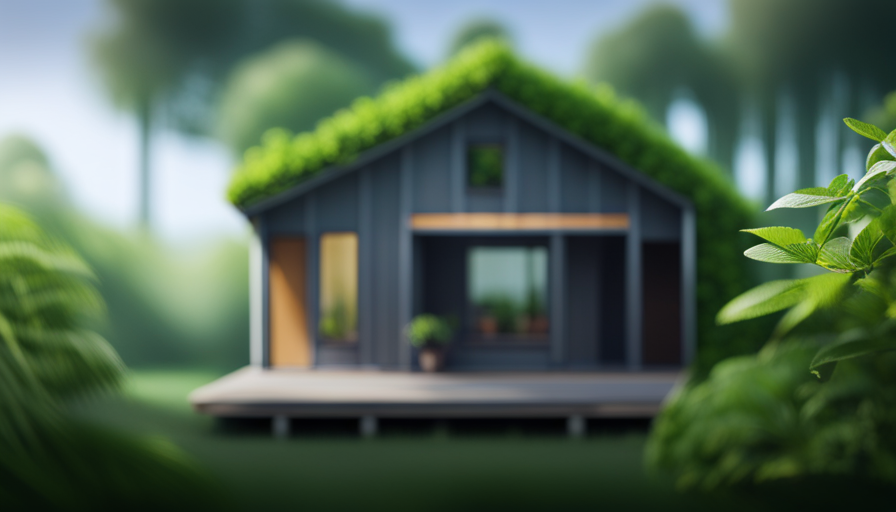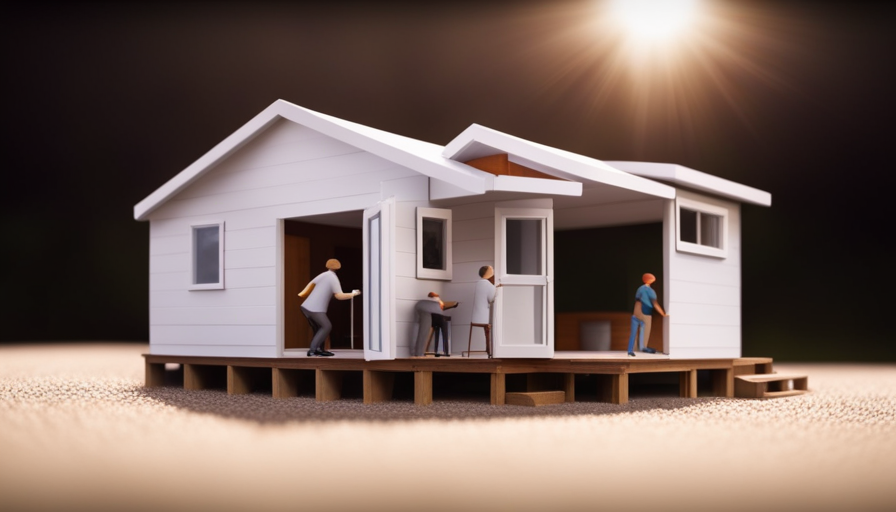Understanding and Increasing Home Energy Efficiency
How Much Energy Will a Whole House Fan Use?

Before installing a whole house fan, understanding its energy consumption is essential. Here are several strategies aimed at minimizing the energy used by this fan. It’s important to recognize that these suggestions are not a universal fix. Rather, they’re designed to assist you in making educated choices on whether this is an appropriate and fitting option for both you and your household.
Cost of running a whole house fan
The cost of running a whole house fan varies depending on the model. A one-speed model can cost as little as $600, while a variable-speed model may cost anywhere from $1,350 to $1,850. A two-speed model gives homeowners greater control over the airflow. The higher speeds, however, are generally louder.
The coolest time of day to use a whole-house fan is when the air is cooler than outside. This allows the cold air to circulate in your home for longer times. You can also turn it on at night when it is most quiet. The fan should also be switched on at least a couple of hours before bed.
The cost of running a whole house fan depends on the size of your house. A 36-inch model with 7,000 CFM can cost as much as $1,600. A 20-inch fan with a similar capacity can cost between $400 and $1,300. Electrical permits vary, but the cost can range from $10 to $500.
The installation of a whole house fan can be expensive, especially if you need to cut holes in your ceilings. To install the fan, you might need to hire a carpenter. You may also need to wire the fan, which can cost up to $300.
The cost of running a whole-house fan will depend on the size of your house and the number of rooms. Some models use a direct-drive motor while others use belt drive motors. The direct-drive versions cost more, but they are quieter. In addition, you can save money on your electric bill by running a whole-house fan in your home.
Installing a whole-house fan involves cutting the opening in the ceiling, framing support within the attic beams, mounting the fan and wiring it. A professional electrician can complete the job or you can do the installation yourself. It will cost you between $200 and $260 to do it yourself.
Whole house fans can last up to 20 years if properly maintained. They do need to be replaced occasionally. The life expectancy of a whole-house fan is dependent on how frequently it is used and how well it is maintained. Many models come with extended warranties of up to fifteen years.
Whole house fans can be expensive to install, so it’s essential to know the costs involved. A professional installation can cost from $300 to $1,000. It can take anywhere from four to eight hours to complete. Installing the fan, a dedicated circuit, and a wall switch can add a few hundred dollars to the overall cost.
The cost of running a whole house fan is relatively low compared to the cost of central air conditioning. The cost of running a whole house fan will be between one and five dollars an hour, which is much less than the cost of central air conditioning. The unit consumes around ten percent less electricity per hour than central air conditioning. If you live in a warm climate with lower humidity, a whole house fan can save you a lot of money and energy.
Energy efficiency of whole house fans
Whole-house fans can reduce your energy costs and improve the air quality in your home. The Environmental Protection Agency and the American Lung Association estimate that the concentration of pollutants inside our homes is between two and five times higher than what we find outdoors. They can also help reduce carbon monoxide levels, which can be drawn in through windows and doors.
Whole house fans can be a worthwhile investment if you live in a warm climate. This type of ventilation system is not suitable for every house. Make sure you research it before you purchase one. Also, make sure to check for tax incentives available in your area. You might be eligible for rebates from your local government to offset the cost of installing whole-house fans.
Another major benefit of whole house fans is that they are highly effective in cooling homes. They are installed in the ceiling or attic and help to remove hot air from the house and replace it by cooler air from outside. Typically, residents will turn the whole house fan on when the temperature outside drops below the temperature inside. To get the best benefit, they will want to leave the fan on for several hours or overnight.
Whole-house fans are less expensive to run than central air conditioning systems. On average, a typical whole house fan uses only about 10 to 15% of the power used by a central air conditioning system. You can expect to save several hundred dollars per month on your energy bills if you keep this in mind.
The amount of fresh air a whole house fan draws in is the best indicator of its efficiency. A 24-inch fan with a 1/3 horsepower motor can draw up to three hundred cubic yards per minute (cfm), of air against a water pressure drop of one-inch. When the fan is operating at a high speed, it can draw up to 2,060 cfm of air.
Whole house fans are often noisy. While some fans are quieter than others, they still make a lot of noise. Small ceiling mounted fans tend to be the noisiest. For this reason, you should consider a dual-speed or variable-speed WHF for a quieter home. This will allow you to control the fan speed and reduce the noise level while keeping the energy usage low.
Cooling a house with whole house fans is the cheapest way to cool it. Whole house fans are the standard in seven climate zones of California. They can also be an effective means of drying your hair quickly.
Pollutants sucked up by a whole house fan
Whole house fans are a great way to improve the air quality in your house. They work by replacing the air inside your house with fresh air from outside. Without a constant flow of air, indoor air pollution builds up over time. This pollution comes from various household items, pets, and dust mites. When your house is closed up, the air cannot circulate and pollutants can concentrate in the attic and lower levels of your home. A whole house fan works by letting fresh air flow through your house from bottom to top.
Hi, I’m Emma. I’m the Editor in Chief of Tiny House 43, a blog all about tiny houses. While tree houses are often associated with childhood, they can be the perfect adult retreat. They offer a cozy space to relax and unwind, surrounded by nature. And since they’re typically built on stilts or raised platforms, they offer stunning views that traditional homes simply can’t match. If you’re looking for a unique and romantic getaway, a tree house tiny house might just be the perfect option.
Understanding and Increasing Home Energy Efficiency
Tiny House Environmental Benefits

Have you ever pondered the environmental benefits of residing in a tiny house? Allow me to illustrate this for you.
Imagine a world where energy consumption is minimized, carbon emissions are lowered, and sustainable materials are utilized. In this world, minimalism and conscious consumption thrive, and off-grid living is supported. People are connected with nature, finding solace in its beauty and preserving it for future generations. Innovative design solutions are inspired, leading to creative ways of maximizing space and reducing waste.
The environmental impact is greatly reduced, and awareness and advocacy for sustainable living are spread far and wide. This is the world of tiny houses, where size doesn’t dictate the impact.
In this article, we will explore the myriad of environmental benefits that come with embracing the tiny house movement. Get ready to be inspired and enlightened as we delve into the world of tiny house environmental benefits.
Key Takeaways
- Tiny houses minimize energy consumption through energy-efficient appliances and renewable energy sources like solar panels and wind turbines.
- Living in a tiny house reduces carbon emissions by utilizing renewable energy and prioritizing public transportation.
- Sustainable materials, such as reclaimed wood and recycled metal, are used in the construction of tiny houses, reducing the demand for new resources and lowering greenhouse gas emissions.
- Tiny houses promote minimalism and conscious consumption, leading to less waste generation and a more sustainable use of resources.
Minimizing Energy Consumption
Did you know that one of the biggest advantages of living in a tiny house is the ability to minimize energy consumption? Tiny houses are designed to be energy efficient, utilizing energy-saving appliances that consume less electricity compared to their larger counterparts. These appliances, such as compact refrigerators and low-wattage lighting fixtures, can significantly reduce overall energy usage.
Additionally, many tiny houses incorporate renewable energy sources, such as solar panels or wind turbines, to generate electricity and further reduce dependence on traditional power grids. By harnessing the power of these renewable sources, tiny house owners can not only save on energy costs but also contribute to a more sustainable future.
Transitioning into the subsequent section about ‘lowering carbon emissions,’ it is evident that tiny houses play a crucial role in promoting environmentally friendly lifestyles.
Lowering Carbon Emissions
By reducing the size of their living space and implementing sustainable practices, tiny house dwellers can significantly shrink their carbon footprint. One way they achieve this is by utilizing renewable energy sources to power their homes. Solar panels, for example, can provide clean and renewable energy, reducing the reliance on fossil fuels. Additionally, tiny house dwellers often choose to live in communities that prioritize public transportation. This reduces the need for individual car ownership and decreases carbon emissions associated with transportation.
By lowering their carbon emissions through the use of renewable energy sources and public transportation, tiny house dwellers contribute to a more sustainable future. Another important aspect of sustainable living is utilizing sustainable materials in the construction of tiny houses. This helps to further minimize the environmental impact and will be discussed in the next section.
Utilizing Sustainable Materials
When you choose to incorporate sustainable materials into your construction projects, you’re making a conscious effort to align your actions with your values and prioritize the health of our planet.
Sustainable building practices and the use of eco-friendly construction materials have numerous environmental benefits. Firstly, sustainable materials, such as reclaimed wood and recycled metal, reduce the demand for new resources and minimize waste.
Secondly, these materials often have a lower carbon footprint compared to traditional building materials, helping to lower greenhouse gas emissions.
Lastly, sustainable materials are often non-toxic and free from harmful chemicals, ensuring a healthier living environment for occupants.
By utilizing sustainable materials, we can contribute to a greener and more sustainable future. Encouraging minimalism and conscious consumption is the next step towards achieving this goal.
Encouraging Minimalism and Conscious Consumption
When it comes to encouraging minimalism and conscious consumption, two key points come to mind: downsizing possessions and reducing waste, and promoting a simpler and more sustainable lifestyle.
By embracing minimalism and reducing our reliance on material possessions, we can not only declutter our lives, but also reduce our environmental impact.
Additionally, promoting a simpler lifestyle can lead to less waste generation and a more sustainable use of resources, ultimately contributing to a more environmentally conscious society.
Downsizing possessions and reducing waste
Minimizing possessions and cutting down on waste are key factors in the environmental benefits of living in a tiny house. By reducing clutter, tiny house dwellers are able to live with only the essentials, which means fewer resources are needed to produce and maintain their belongings.
Additionally, living in a smaller space encourages conscious consumption and discourages unnecessary purchases. This promotes recycling, as people are more likely to repair or repurpose items instead of throwing them away.
Furthermore, downsizing possessions also leads to a reduction in waste generation. With limited storage space, individuals are more likely to think twice before buying something, considering its lifespan and environmental impact.
As a result, living in a tiny house fosters an environmentally conscious mindset and encourages sustainable practices. Transitioning into the subsequent section about promoting a simpler and more sustainable lifestyle, these practices extend beyond material possessions.
Promoting a simpler and more sustainable lifestyle
To live a simpler and more sustainable lifestyle, you can embrace the freedom of a tiny house and watch your environmental impact shrink like a deflating balloon. Tiny houses promote a more sustainable lifestyle by encouraging downsizing and reducing waste.
But it doesn’t stop there. Living in a tiny house also opens up opportunities to adopt sustainable transportation options, such as biking or using public transit, which further reduces your carbon footprint. Additionally, many tiny houses are designed to be energy-efficient and can be powered by renewable energy sources like solar panels or wind turbines. By embracing these sustainable practices, you not only reduce your environmental impact but also save money on energy bills.
Supporting off-grid living is the next step towards a more sustainable and self-sufficient lifestyle.
Supporting Off-Grid Living
Although it may seem challenging at first, embracing off-grid living in a tiny house can lead to a more sustainable and self-reliant lifestyle. By supporting self-sufficiency and promoting eco-friendly alternatives, tiny houses offer numerous benefits for those seeking to reduce their environmental impact. Living off-grid in a tiny house means relying on renewable energy sources such as solar panels or wind turbines, reducing dependence on fossil fuels. Additionally, these homes often utilize composting toilets and rainwater collection systems, minimizing water waste. In a society where consumption is the norm, tiny houses encourage a simpler and more sustainable way of living. They promote a conscious mindset about resource consumption and waste reduction. Embracing off-grid living in a tiny house not only decreases our carbon footprint but also creates a more harmonious relationship with nature. Transitioning to the next section, promoting sustainable land use, is the next logical step in creating a greener future.
Promoting Sustainable Land Use
In promoting sustainable land use, two key points that are important to consider are the smaller physical footprint and land requirements of sustainable practices, as well as the emphasis on community and shared spaces.
By adopting sustainable practices such as compact housing and minimal land use, we can reduce our ecological impact and preserve natural resources.
Additionally, fostering a sense of community and encouraging shared spaces can lead to more efficient land use and a stronger sense of connection among residents.
Smaller physical footprint and land requirements
By living in a tiny house, you can minimize your physical footprint and reduce the amount of land you require. This not only benefits the environment but also offers several advantages for homeowners. Here are four reasons why smaller physical footprints and land requirements are beneficial:
- Smaller housing costs: Tiny houses are more affordable to build and maintain compared to traditional homes, allowing homeowners to save money and reduce their financial burden.
- Efficient space utilization: Tiny houses are designed to maximize every square inch of space, resulting in a more functional and organized living environment. This promotes a minimalist lifestyle and reduces the need for excessive consumption.
- Reduced environmental impact: With less land required for a tiny house, there is a decreased need for deforestation and disruption of natural habitats. This helps to preserve ecosystems and protect biodiversity.
- Lower energy consumption: Tiny houses typically have a smaller carbon footprint due to their reduced energy needs. Heating, cooling, and powering a tiny house requires less energy, resulting in lower utility bills and environmental impact.
By emphasizing community and shared spaces, tiny house living encourages a more sustainable and connected way of life.
Emphasizing community and shared spaces
Transitioning from the smaller physical footprint and land requirements of tiny houses, we now delve into the aspect of emphasizing community and shared spaces. One of the remarkable aspects of the tiny house movement is its emphasis on fostering community engagement and reaping social benefits. Tiny house communities often feature shared amenities such as communal gardens, recreation areas, and common spaces, encouraging residents to interact and connect with one another. This promotes a sense of belonging and support network, which is often lacking in larger, more isolated neighborhoods. Additionally, shared spaces can also reduce the environmental impact of each individual tiny house, as resources like land, water, and energy can be shared among the community members. By embracing community and shared spaces, the tiny house movement goes beyond just downsizing and creates a more connected and sustainable way of living.
Moving forward, let’s explore how tiny houses foster connection with nature.
Fostering Connection with Nature
Living in a tiny house allows individuals to reconnect with nature and experience its benefits firsthand. One interesting statistic is that spending time in nature has been shown to lower cortisol levels by 16%. Fostering mindfulness and promoting outdoor activities are key aspects of tiny house living that contribute to this connection with nature.
With limited space indoors, individuals are encouraged to spend more time outdoors, engaging in activities like gardening, hiking, or simply enjoying the surrounding natural beauty. This increased exposure to nature has been linked to improved mood, increased creativity, and enhanced overall well-being.
By fostering this connection with nature, tiny houses inspire innovative design solutions that integrate the natural environment seamlessly into the living space, creating a harmonious blend of comfort and sustainability.
Inspiring Innovative Design Solutions
Embracing the harmonious blend of comfort and sustainability, innovative design solutions are inspired by the connection with nature fostered in tiny houses. These dwellings challenge architects to think outside the box and come up with creative architectural designs that maximize space without compromising on functionality.
Innovative space-saving solutions such as built-in storage units, multipurpose furniture, and collapsible features are becoming increasingly popular in tiny house design. These solutions not only optimize the use of limited space but also contribute to a clutter-free and organized living environment.
Additionally, the incorporation of natural light, ventilation systems, and green building materials further enhance the overall sustainability of these homes. By embracing these innovative design solutions, tiny houses offer a glimpse into the future of sustainable living, reducing environmental impact while providing a comfortable and inspiring living space.
Transitioning into the subsequent section about reducing environmental impact, it is important to consider the energy-efficient features of tiny houses.
Reducing Environmental Impact
When it comes to reducing environmental impact, tiny houses have a lot to offer. One key benefit is lower water usage and more efficient wastewater management systems. By utilizing innovative technologies such as composting toilets and greywater recycling systems, tiny houses are able to minimize water consumption and reduce the need for traditional sewage systems.
Additionally, the construction of tiny houses causes less environmental disturbance compared to traditional housing, as they require fewer materials and have a smaller footprint on the land.
Lower water usage and wastewater management
Reduce your water consumption and manage wastewater more efficiently in your tiny house, all while enjoying the perks of modern amenities. Water conservation is a key aspect of sustainable living, and tiny houses provide an excellent opportunity to implement effective strategies.
With limited space and resources, it becomes essential to adopt practices that minimize water usage. Low-flow fixtures, such as faucets and showerheads, can significantly reduce water consumption without compromising comfort. Additionally, installing water-efficient appliances, like dishwashers and washing machines, further contributes to sustainable water management.
Wastewater can be managed through the use of composting toilets or greywater systems, which treat and reuse water from sinks and showers for non-potable purposes.
By implementing these measures, tiny house dwellers can reduce their environmental impact and promote a more sustainable way of living. This focus on efficient water usage sets the stage for the subsequent section on decreased environmental disturbance during construction.
Decreased environmental disturbance during construction
Minimize the disruption to the natural surroundings by carefully planning and constructing your tiny home with minimal impact on the surrounding ecosystem.
When building a tiny house, there are several ways to achieve this goal. Firstly, by using lightweight and eco-friendly materials, the overall noise pollution during construction can be significantly reduced. Traditional construction methods often involve heavy machinery and loud equipment, which can disturb wildlife and nearby residents.
Secondly, incorporating sustainable design features such as natural ventilation and efficient insulation can improve air quality both during and after construction. By reducing the need for artificial heating and cooling systems, tiny houses can minimize energy consumption and decrease air pollution.
By implementing these practices, tiny homes can be built with minimal environmental disturbance.
Transitioning into the next section, spreading awareness and advocacy is crucial for the widespread adoption of tiny houses as a sustainable housing option.
Spreading Awareness and Advocacy
Spread the word about the environmental benefits of tiny houses and advocate for their adoption in your community. Raising awareness and advocating for change are crucial in promoting the use of tiny houses as an eco-friendly housing option. By spreading the word, we can educate others about the positive impact of tiny houses on the environment. Advocacy involves actively engaging with local governments, community organizations, and individuals to promote the adoption of tiny houses as a sustainable housing solution. This can be done through public speaking engagements, writing articles or blog posts, and organizing events to showcase the benefits of tiny houses. By working together, we can create a movement that encourages more people to consider the environmental advantages of tiny houses and take action towards a greener future.
| Advantages of Spreading Awareness and Advocacy | How it Benefits the Environment | ||
|---|---|---|---|
| Increases knowledge about tiny houses | Encourages sustainable living | ||
| Inspires others to consider eco-friendly options | Reduces carbon footprint | ||
| Creates a sense of community | Promotes resource conservation | ||
| Drives policy change | Fosters a greener future | Provides affordable housing solutions |
Frequently Asked Questions
How much does it cost to build a tiny house?
When considering the cost factors of building a tiny house, it’s important to take into account various aspects such as the size, location, and complexity of the design. Additionally, the choice of building materials can greatly impact the overall cost.
While the price can vary significantly based on individual preferences and requirements, generally speaking, building a tiny house can range from $20,000 to $100,000. The cost can be influenced by factors such as labor, permits, and the quality of materials chosen.
Are tiny houses legal in all areas?
Tiny house regulations and zoning restrictions vary from area to area. Some places embrace the minimalist lifestyle and have specific regulations in place to accommodate tiny houses. Others may have stricter rules or outright bans. It’s important to research local laws and regulations before embarking on a tiny house project. Consult with local authorities and educate yourself on the specific requirements and limitations in your desired location.
What are the challenges of living in a tiny house?
Living in a tiny house presents both challenges and advantages. One challenge is the limited space, requiring careful organization and minimalism. However, this can also promote sustainability and reduce one’s carbon footprint.
Despite the space constraints, tiny houses often incorporate space-saving designs and innovative storage solutions, maximizing every inch of available space. This focus on space efficiency not only allows for a more sustainable lifestyle but also encourages a simpler and more mindful way of living.
Can you have a family in a tiny house?
Oh, of course! Who wouldn’t want to cram a family of four into a glorified shoebox? Space limitations are just a small price to pay for the joy of constant claustrophobia. But fear not, for tiny house enthusiasts have come up with the ingenious concept of designing for multi-functionality. That means your kitchen table doubles as your child’s bunk bed! Who needs personal space when you can have a never-ending game of Tetris with your furniture?
How do tiny houses impact property values in a community?
Tiny houses can have both positive and negative impacts on property values in a community. On one hand, they can increase property values by introducing unique and affordable housing options that attract a diverse range of residents.
On the other hand, some people may perceive tiny houses as less desirable, leading to a decrease in property values. It ultimately depends on the local housing market and community development factors.
Conclusion
In conclusion, tiny houses offer a world of environmental benefits. They have minimal energy consumption and carbon emissions, use sustainable materials, and promote conscious consumption. Tiny houses are a powerful tool in combating climate change. They support off-grid living and foster a connection with nature, reminding us of the beauty and fragility of our planet. Their innovative design solutions and reduced environmental impact inspire us to think creatively and responsibly. By spreading awareness and advocating for tiny houses, we can create a brighter, greener future for generations to come.
I’m Theodore, and I love tiny houses. In fact, I’m the author of Tiny House 43, a book about tiny houses that are also tree houses. I think they’re magical places where imaginations can run wild and adventures are just waiting to happen.
While tree houses are often associated with childhood, they can be the perfect adult retreat. They offer a cozy space to relax and unwind, surrounded by nature. And since they’re typically built on stilts or raised platforms, they offer stunning views that traditional homes simply can’t match.
If you’re looking for a unique and romantic getaway, a tree house tiny house might just be the perfect option.
Understanding and Increasing Home Energy Efficiency
Who Evaluates Your House For Energy Efficiency?

An energy consultant will describe the approach and instruments utilized to assess your home. This will involve the use of a blower door test to gauge the airtightness of your residence. Additionally, the consultant will check the positions of any mechanical systems. You might have to ensure they have unobstructed entry to evaluate the insulation and seal of your attic effectively.
Home energy rating
Energy efficiency is becoming increasingly important in our current economy, and many people are now looking for greener homes. Homeowners can improve the energy efficiency of their homes by making upgrades. Green home improvements can save not only the environment but also increase the home’s value. The Home Energy Score will give you the information you need in order to make informed decisions about how your home uses energy.
The energy advisor will explain everything to you before the evaluation can start. The advisor will take photos of various aspects of your house, including its mechanical systems, attic space, and wood-burning appliances. They will also explain the tools that they will use during the evaluation.
The Home Energy Score is a national standard used to assess the energy efficiency of a house. The rating system is designed to protect homeowners and prospective buyers. The Residential Energy Services Network (RESN) is an independent, nonprofit organization that developed rigorous testing and training standards for the process. The report provides recommendations on how to improve your home’s efficiency and includes an analysis of its efficiency.
A certified home energy assessor will help you understand your home’s energy consumption and recommend cost-effective upgrades. These assessors usually have certification and training from the Department of Energy. They will conduct a home energy audit from the attic to basement. The report will also include an EnerGuide rating.
A professional can conduct an energy assessment, or a homeowner can do it. A home energy assessment will include a checklist of upgrades that will help you prioritize your energy upgrades. A home energy assessment can be a valuable tool for making smart decisions about home improvement projects. However, it is not recommended that you attempt to do the work yourself unless your certification in the field is obtained. For example, if you know nothing about energy efficiency, you may end up spending more than you need to.
For a comfortable and healthy home, energy audits are essential. A certified energy auditor will look for inefficient appliances, rooms and the overall design of your home. If you need to improve energy efficiency, you may want to consider hiring a professional who has access to difficult to reach areas of the house and has access to infrared cameras.
Home energy audits provide customized reports and recommendations for improvements that will increase your house’s energy efficiency and lower your bills. These reports will be tailored to your budget and your needs. Some of the recommended improvements are easy enough to implement yourself, while others may require the assistance of a qualified contractor. There are many benefits to hiring a qualified contractor to perform these improvements. You’ll also receive a $100 SRP rebate that will be applied as an instant discount to your contractor’s invoice.
In addition to reducing monthly expenses, improving your home’s energy efficiency can also increase its value. It doesn’t matter if you’re buying a house for yourself or as an investment property. You should consider how energy efficient it is. By doing this, you can make your home more comfortable and increase its market value.
You’ll often pay a fee to hire an energy assessor to evaluate your home. If you are low-income, you may qualify for a free home energy assessment. Depending on your income, you may also qualify for extra incentives for qualifying energy-saving services. You should ensure that the costs of these improvements do not exceed the savings you will see over the long-term.
An energy audit is an important investment in improving your home’s energy efficiency. You can save money and improve your health with an energy assessment. By making home improvements, you’ll improve your home’s quality of life, reduce your utility bills, and create a safer environment for yourself and your family. You may be eligible for federal tax incentives to improve your energy efficiency.

Home energy audit
If you’re interested in lowering your home’s energy bills, hiring an expert to evaluate your house for energy efficiency is an excellent idea. These experts know the latest techniques and tools for conducting energy assessments. They also know where to look for potential issues. They may use tools such as thermal imaging cameras or radiometers to determine where your home loses energy.
A home energy audit will help you find opportunities for energy efficiency upgrades and make recommendations for improvements. The process can be a DIY project or a professional service. Although most people can perform the process themselves, hiring a professional is recommended when you don’t have the time or the necessary tools. A home energy audit checks for air leaks at junctures in walls and floors, doors and light switches, plumbing fixtures, and electrical outlands. It also checks for air leaks in your home, which can lead to high energy costs.
A home energy audit is the best choice if you want to lower your energy bills and improve your home’s comfort. An auditor will evaluate your house room by room, using special tools and cameras to find the problem areas. An auditor will also provide an estimate of the cost savings associated with different home improvements. You can find certified auditors through the Residential Energy Services Network directory or your local utility company. Many utility companies even offer subsidized energy audits for homeowners.
An energy assessment will include an analysis of the cost and benefits of energy efficiency upgrades. This means that the cost of the improvements will be worth the investment over the lifetime of your home. A qualified home energy assessment will give you a clear picture about which improvements are most beneficial and cost-effective. The report will also include recommendations for upgrades to boost your home’s efficiency.
Before an energy advisor visits your house, you must sign a consent form. It’s important to review the consent form carefully. Once you have agreed to the evaluation, the advisor will explain the evaluation process to you. The advisor will take photos of your home’s mechanical systems, attic space and wood-burning appliances. The tools used in the evaluation will be explained to you in detail.
While a certified energy auditor can recommend energy efficiency upgrades, it’s important to understand that no one assessment can meet all customer’s needs. In addition, various incentives are available for homeowners who make energy efficiency improvements. You can get a tax credit for upgrading your heating and air conditioning systems. You can also receive a rebate if you install on-site renewables such as solar photovoltaic systems or geothermal heat pumps.
An energy assessment can identify energy leaks and repair appliances that are in need of replacement or repair. A thorough home energy assessment can help you save money on your utilities bills. Although it is easy to do, it takes diligence. The results can give you a roadmap to lower your energy bills and improve your comfort.
There are two types of home energy assessments: general and detailed. To complete a general home energy audit, a certified energy auditor must be hired to gather detailed information about your house’s energy consumption. A professional energy auditor can identify areas that need improvement and is more thorough. You can also use a checklist to conduct your own home energy assessment.
An energy audit can help you make informed choices about how to improve your home’s energy efficiency. You will receive detailed reports highlighting areas where your house is using too much electricity and areas where you can improve its efficiency. These changes will help you save money and combat climate change.
A RESNET ratingr will determine the home’s HERS rating. The rater will compare your home to a standard reference house that meets code using specialized software. The resulting rating is usually a number between 0 and 150. For example, a score of 50 indicates your home uses 50% less energy than the code. A high HERS score can help your home earn an ENERGY STAR (zero energy) certification.
Energy efficiency can increase your home’s value and help you save money. Regardless of what your budget is, it’s a good idea to invest in energy-efficient upgrades and make your home more energy-efficient.
Hi, I’m Emma. I’m the Editor in Chief of Tiny House 43, a blog all about tiny houses. While tree houses are often associated with childhood, they can be the perfect adult retreat. They offer a cozy space to relax and unwind, surrounded by nature. And since they’re typically built on stilts or raised platforms, they offer stunning views that traditional homes simply can’t match. If you’re looking for a unique and romantic getaway, a tree house tiny house might just be the perfect option.
Understanding and Increasing Home Energy Efficiency
The Whole House Approach to Energy Efficiency

The whole-house approach to enhancing energy efficiency comprises multiple elements. This strategy aims to lower energy consumption and decrease reliance on active energy systems. It emphasizes passive energy-saving methods, like the utilization of energy-efficient appliances and disconnecting them when they’re not in operation. Additionally, it seeks to diminish the loss of heat.

RESNET’s industry-leading standards improve home energy efficiency
The Residential Energy Services Network (RESNET) is the leading national authority on home energy performance. Its standards are widely recognized and implemented by government agencies and the building industry. Its HERS (Home Energy Rating System) index provides a clear picture of a home’s energy efficiency. Consumers will be able better understand the benefits and costs associated with buying a new home.
The whole-house system approach is the best way to maximize home energy efficiency. This approach looks at a home as a unified unit, resulting in a highly energy-efficient home that reduces utility bills and improves home comfort. A certified RESNET Home Energy Specialist can help homeowners maximize their home’s potential for energy efficiency.
RESNET’s Home Energy Rating System Index (HERS) is a nationally recognized system that measures a house’s energy performance. Its benchmarks are equivalent to those set by the U.S. Environmental Protection Agency and the Department of Energy. A home with a lower HERS Index score has higher energy efficiency and lower energy bills.
The HERS Index was developed by RESNET and the U.S. Department of Energy, which uses an industry-leading rating system to compare the energy efficiency of a home with a benchmark home. A rating of 50 and higher indicates average energy performance, while 75 and more indicate exceptional energy performance. The EnergySmart Home E-Scale uses an interactive tool to chart the energy savings potential of a home.
In the United States, RESNET is the leading independent authority on home energy performance. RESNET currently has over 43,000 homes in its database. Homes that meet RESNET’s standards will be awarded the Pearl Certification, which reflects the homes’ energy efficiency. This award is presented at RESNET’s annual conference in San Diego.
Buying energy-efficient appliances
Energy-efficient appliances can help you save money on your monthly electricity bill. These appliances may be more expensive at the time of purchase, but the added benefits will be worth it over time. There are many rebate programs that can help you reduce your out-of pocket costs. You may also qualify for incentives for recycling old appliances. For instance, Massachusetts’s Mass Save program offers a $200 rebate for energy-efficient refrigerators, and another $50 for old refrigerators that are not energy-efficient.
Buying energy-efficient appliances is a great way to combat climate change, save money, and protect Mother Earth from the harmful effects of carbon dioxide. According to the US Environmental Protection Agency, efficient appliances use ten to fifty percent less energy and water. Even if your appliances work, you should upgrade them to energy-efficient models.
When shopping for appliances, make sure you look for appliances with the ENERGY STAR label. This symbol is the best way to identify appliances that are energy-efficient. ENERGY STAR certified products meet stringent efficiency standards. They are also supported by an independent third party.
Energy-efficient appliances are a great way to lower your energy bills and boost your economy. This can help save millions of dollars at a national level. These savings will help every homeowner and the nation. It conserves energy and helps the environment. It is possible to save money on your utility bills by purchasing energy-efficient appliances.
Purchasing energy-efficient appliances is an easy way to improve the energy efficiency of your entire house. Many appliances, such as refrigerators, dishwashers, and washers and dryers, are energy-efficient. Using energy-efficient appliances will reduce your energy bills and reduce your carbon footprint. Energy-star-certified appliances are 9 to 50% more efficient than the industry standard.
When appliances are not in use, unplug them
Unplugging appliances when not in use will save you money and energy. Unplugging appliances will reduce the risk of fires. Appliances left plugged in can cause them to heat up and create a fire. This is dangerous and can seriously damage your home. Unplugging appliances will also extend the lifespan of your appliances.
Many people do not think about unplugging their appliances when not in use. It is important to understand that even though your appliance is turned off, it is still wasting energy. Appliances like the stove, oven, and refrigerator still consume energy even when they are not in use.
Many smart home appliances also use phantom electricity. These appliances are connected to the internet constantly and conduct background checks and updates. Unplugging your appliances when not in use can cut down on phantom power and save energy. You can also avoid using a smart device if it is not being used.
In addition to saving money, unplugging your appliances when not in use can also save the environment. The average appliance consumes between one to 10 watts when it is turned off, which is the equivalent of leaving a light bulb on for two hours. Therefore, unplugging appliances when not in use will save you PS80 a year, which is equivalent to powering around 25,000 homes for a year.
According to the Department of Energy, 10 percent of household electricity is phantom power. This energy is also known by the names standby power or vampiric power and is the electricity that small appliances use even after they have been turned off. Phantom energy can be reduced by unplugging unused appliances. It is the most effective way to save money and save the environment.
Reducing heat loss
If you are putting together a renovation project for your home, consider a whole house approach to energy efficiency. This method can help you save money on your energy bill and reduce heat loss. A whole house approach is particularly useful if you live in an older home. This should include an assessment and use of your house’s mechanical systems.
The heating and cooling system is one of the most important areas to improve in your home. Regular maintenance can improve its efficiency. Sealing drafty windows, for example, will stop cold air from escaping in winter or hot air leaking in summer. Insulating these areas can also reduce heat loss. The ceiling and walls are also common areas for heat loss. You can apply insulation to these areas and seal air leaks around switches and outlets.
In addition to reducing heat loss, the whole house efficiency approach recognizes that your home’s entire energy system works together. Even the most efficient furnace can’t compensate for drafts. Drafty doors and windows draw heat from the home. By installing more efficient heat sources and eliminating drafts, you can reduce your energy bills and reduce your carbon footprint.
The EPA has many resources and tools that will help you plan and implement improvements in your home that will lower your heating costs and improve your home’s comfort. In 2004 alone, American homeowners prevented greenhouse gas emissions equivalent to 20 million cars, saved $10 billion, and reduced their heating costs by more than 24 million dollars.
Energy-efficient windows
High-quality windows will reduce energy costs and increase building energy efficiency. Choosing the right type and size of window will also impact the amount of energy you use in your home. You can also add weatherstripping to your windows. Weatherstripping is inexpensive and can be easily installed by homeowners. A high-quality siliconized rubber sealant is another option. This sealant will keep your windows sealed and prevent heat transfer. It will also improve the way your windows warm and cool your home.
Depending on the type of window you choose, energy-efficient windows can save you from thirty to fifty percent on your energy bills each year. While the cost may be higher, you can save up to 12% if you install windows with an ENERGY STAR label. The National Fenestration Rating Council certifies windows as being energy efficient.
U-values should be below 0.30 for energy-efficient windows. This number determines the amount of visible light that is transmitted through the glass. A window with a lower U-value will allow more natural light to pass through but prevent excessive heat from entering the house. Some windows have an inert gas between their panes. These features can improve insulating properties and attract solar energy.
Choosing energy-efficient windows can help you save on your energy bills and reduce your carbon footprint. Energy-efficient windows can save you as much as 12% on your energy bills and up to 300 gallons of gas per window. They also improve the indoor air quality of your home and increase the lifespan of your HVAC system. They can also reduce outdoor noise and condensation.
Hi, I’m Emma. I’m the Editor in Chief of Tiny House 43, a blog all about tiny houses. While tree houses are often associated with childhood, they can be the perfect adult retreat. They offer a cozy space to relax and unwind, surrounded by nature. And since they’re typically built on stilts or raised platforms, they offer stunning views that traditional homes simply can’t match. If you’re looking for a unique and romantic getaway, a tree house tiny house might just be the perfect option.
-

 Beginners Guides2 months ago
Beginners Guides2 months agoHow To Buy A Tesla Tiny House
-

 Energy Efficiency2 weeks ago
Energy Efficiency2 weeks agoBest Tiny Homes For Cold Climates
-

 Beginners Guides2 months ago
Beginners Guides2 months agoTiny House Nation Where Are They Now Stephanie
-

 Tiny House Resources (e.g., legalities, cost, insurance, FAQs)4 weeks ago
Tiny House Resources (e.g., legalities, cost, insurance, FAQs)4 weeks agoDo Tiny Homes Need Planning Permission?
-

 Beginners Guides2 months ago
Beginners Guides2 months agoFrom The Show Tiny House Nation How Many Keep Their Tiny House?
-

 Beginners Guides4 weeks ago
Beginners Guides4 weeks agoUsing a Climbing Net For Treehouse Construction
-

 Beginners Guides4 weeks ago
Beginners Guides4 weeks agoHow to Build a Treehouse Without Drilling Into the Tree
-

 Beginners Guides2 months ago
Beginners Guides2 months agoTiny House Nation Who Pays For The Houses



